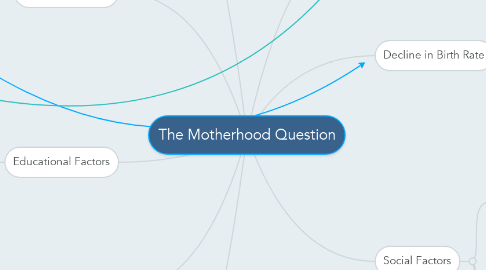
1. Reproductive Necessity
1.1. Pre-industrialization - children were a financial asset as farm and home labor
1.2. Post-industrialization - children became a financial burden and therefore optional
1.3. As the Baby Boomer generation ages, newer generations are needed to sustain economic growth; continue funding government programs that support elderly populations (Burkett, 2000)
1.3.1. Medicare
1.3.2. Social Security
2. Decline in Birth Rate
2.1. Birth rates in the U.S. have been in steady decline since the 1970s
2.1.1. In past generations, reproduction was a sort of inevitability. Women were less selective about who they married, married younger and were expected to be the primary caretakers of the children (products of marriage).
2.2. In general, women are starting families later, and having fewer children
3. Economic Factors
3.1. In general, the longer a woman postpones a first pregnancy, the more likely she will have an increased income throughout her life (Gregory, 2012).
3.2. Older women generally have more secure positions in the workplace, making their financial situation more stable.
3.2.1. Economic stability makes it easier to provide an ideal child-rearing environment.
3.2.1.1. Can shoulder the cost of child care, healthcare, education, and other necessities.
3.2.2. Having an established career generally allows for more flexibility
3.2.2.1. Longer maternity leave
3.2.2.2. More flexible hours
3.3. If a woman chooses to postpone pregnancy, she may have financial resources to pursue the costly alternatives to traditional conception, which becomes increasingly more difficult with age.
3.3.1. Fertility treatments and IVF
3.3.2. Adoption
4. Biological Factors
4.1. A woman's fertility steadily declines as she ages, making it more difficult to conceive. By age 35, pregnancy is universally considered "high risk."
4.1.1. Risks to infants born to women 35+ include birth defects (Downs' Syndrome), premature birth
4.1.2. Older first-time mothers may have less energy to nurture, care for, and "chase after" a small child than women in their 20s and early 30s.
4.1.3. Women may feel pressured by their gynecologists, however well-meaning, who remind women of their "ticking clock"
4.2. After a certain point, it becomes biologically impossible for a woman to conceive.
4.2.1. Pursue alternatives
4.2.2. Remain childless
4.3. The invention of hormonal birth control has influenced the declining birth rate.
4.4. Reproduction as a basic, primal human instinct.
5. Educational Factors
5.1. Childless women tend to be more educated than women with children (Livingston and Cohn, 2010).
5.1.1. Income tends to increase with the level of education completed.
5.2. The desire to complete one's education can influence a woman's postponement of a first pregnancy.
6. Social Factors
6.1. Marital and relationship status strongly influence a woman's reproductive choices
6.1.1. The majority of women wait until they find a suitable partner to have their first child. With the average age of first marriages increasing, so is the age at which women have their first child.
6.1.1.1. Maintaining marriage or long-term relationship and raising child together
6.1.1.2. Raising child alone after a divorce, separation, or pregnancy resulting from a non-involved individual
6.1.2. Women choosing to have children on their own (can be costly)
6.1.2.1. Adoption
6.1.2.2. Sperm donation
6.1.2.3. Surrogacy
6.2. Peer influence - Women tend to feel the pressure to have babies as their peers begin families. This can be a tremendous influence on a woman emotionally, and can cause internal and relationship conflict if she does not feel ready to bear her old children.
6.2.1. "Baby fever" and "baby lust:" The intense feelings of sentimentality when presented with images of babies or images with parents with them, or inspired by "baby stuff" in general culture.
6.3. Familial pressure
6.3.1. "So when are you having kids?"
6.4. For those who have asserted a desire to not reproduce, there tends to be a pushback, met with statements like, "you'll change your mind," or "you still have time."
7. Cultural & Societal Factors
7.1. Now more than ever, motherhood and maternity are universally celebrated.
7.2. Rise in "natalist culture"
7.2.1. Cultural preoccupation with celebrity moms, reality tv, increase in "mommy blogs," Pinterest, parenting and motherhood magazines
7.3. There is an unwritten societal expectation that motherhood is synonymous with womanhood. It is generally assumed that every woman, given the opportunity, wants a child (or children). Women who elect to remain childless by choice may be seen as "selfish."
7.3.1. For women who elect not to have children, there tends to be a stigma that doesn't exist for men.
8. Personal Factors
8.1. The desire to be economically prepared, have an established career and supportive partner are collectively important
8.2. Reservations surrounding birth and pregnancy
8.2.1. Fear of health risks for self and child (especially after 35)
8.2.2. Concerns of painful/challenging labor, difficult pregnancies, and ravages to the physical body
8.3. Establishment of self and maintaining personal identity while balancing career and motherhood
8.3.1. Attempt to balance career & motherhood, the notion of "having it all"
8.3.2. Make motherhood the central priority in life and primary source of identity (i.e. become a stay-at-home mom)
8.3.3. Forgo motherhood in favor of career, educational, and personal fulfillment
